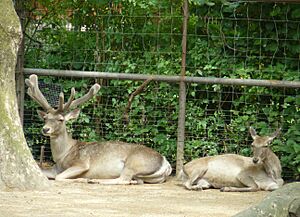Bactrian deer facts for kids
Quick facts for kids Bactrian deer |
|
|---|---|
 |
|
| Male (Stag) | |
| Scientific classification |
|
| Kingdom: | Animalia |
| Phylum: | Chordata |
| Class: | Mammalia |
| Order: | Artiodactyla |
| Family: | Cervidae |
| Subfamily: | Cervinae |
| Genus: | Cervus |
| Species: | |
| Subspecies: |
C. e. bactrianus
|
| Trinomial name | |
| Cervus elaphus bactrianus Lydekker, 1900
|
|
The Bactrian deer is also known as the Bukhara deer. It is a type of red deer that lives in lowlands. You can find this deer in Central Asia. It likes to live near rivers in areas surrounded by deserts. It is similar to the Yarkand deer, but these two deer are separated by the Tian Shan Mountains.
Contents
What Does the Bactrian Deer Look Like?
This deer usually has a gray color with a yellowish shine. It has a grayish-white patch on its rump, which is its backside. You might also see a faint stripe down its back. The edges of its upper lip, lower lip, and chin are white.
The antlers of the Bactrian deer are light in color. They usually have four points, called tines. The fourth tine is often bigger than the third one. Fully grown deer can have five tines on each antler. These antlers have a special bend after the third tine, which is common for many red deer in Central Asia.
Bactrian deer have short tails, much like the wapiti deer. Their tails are similar to those of the Yarkand deer.
Baby Bactrian deer, called calves, are usually born with spots. This is similar to how European red deer calves look. Most of these spots disappear as the deer grow into adults. However, some adult Bactrian deer might still have a few spots on their backs during the summer.
Where Do Bactrian Deer Live?
This deer lives in central Khorasan. You can find it in Russian Turkestan and nearby parts of northern Afghanistan. These areas are west of the Tian Shan Mountains.
Bactrian deer live in lowland areas near rivers. These river areas have mixed trees like willow and poplar. Deserts surround these green river corridors. These deer do not migrate, meaning they don't travel long distances seasonally. However, they might move into nearby desert areas at night or when the weather is cooler.
How Many Bactrian Deer Are There?
In 1999, there were fewer than 400 Bukhara deer left. The number of deer dropped a lot in Tajikistan because of military conflicts.
However, since then, environmental groups have worked hard to save this deer. The World Wide Fund for Nature (WWF) started a program to bring the Bukhara deer back to places where they used to live. For example, Bactrian deer have been brought back to the Zarafshan reserve in Uzbekistan.
Because of these efforts, by 2006, there were about 1,000 deer in Central Asia. In 2009, the largest wild groups were found in the Karatchingil Nature Reserve in Kazakhstan, with 320-350 animals. There were also 374 animals in the Badai Tugai Nature Reserve in Uzbekistan. More than 150 animals lived in the Tigrovaya Balka Nature Reserve in Tajikistan. The total wild population is now around 1,430 and is still growing.
Who Are Their Predators?
Besides humans, the wolf is likely the most dangerous predator for most Central Asian red deer. Sometimes, the brown bear will also hunt these deer. Other animals that might prey on them include dholes and snow leopards.
Smaller predators like the Eurasian lynx and wild boars sometimes hunt the young calves. In the past, the now extinct Caspian tiger also hunted Bactrian deer.
Images for kids



